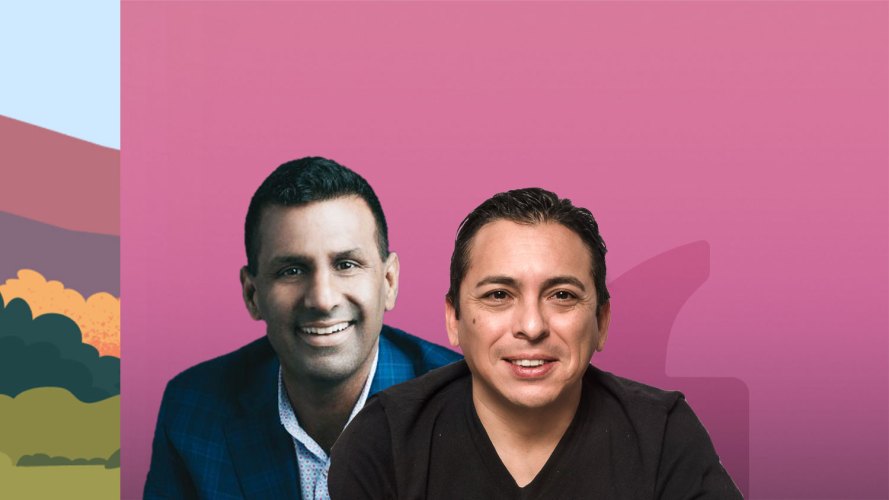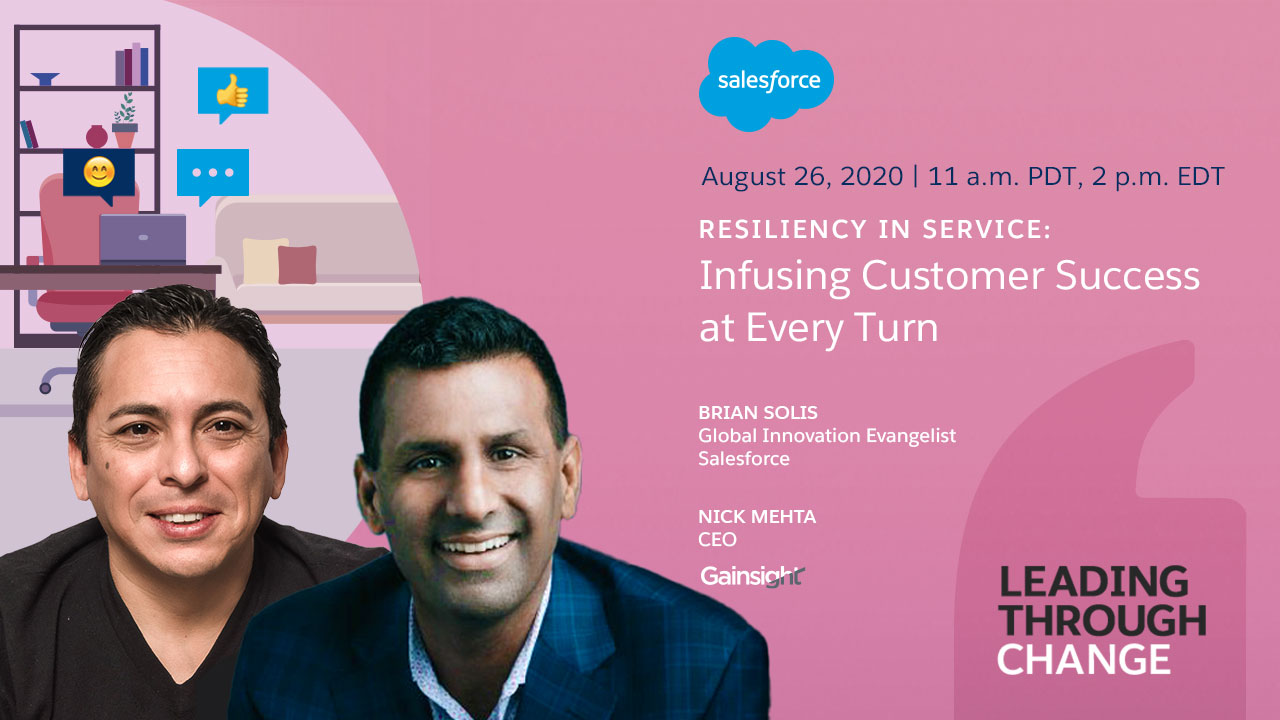This blog is part 4 of our 5 part series in which Brian Solis, Salesforce’s Global Innovation evangelist, speaks with our customers about how they’ve transformed to adapt to change since COVID-19 hit in March.
What’s the difference between customer-centricity, customer experience, and customer success? That’s the question I asked Gainsight CEO Nick Mehta, a company that helps companies increase revenue, decrease customer churn, and drive advocacy. Aside from having the word “customer” in each, what’s important to appreciate is that the definitions of and the differences between each is not as much about how you and I interpret them, but instead how customers describe them and the engagement they have with your company throughout their journey.
Customer-centricity, customer experience, and customer success are each, in their own right, important. Executives have long touted how customers are important and at the center of everything they do. But this doesn’t necessarily mean customers are, first-and-foremost, the reason for which they make decisions. Oftentimes, shareholders and stakeholders take precedence. If we look historically, before the pandemic, it was estimated that four out of five digital transformation (DX) efforts failed. Among the many reasons for failure, DX strategies often lacked purpose, unity, cross-functional support, and measures of success.
The truth is DX was largely considered a cost center by shareholders and stakeholders, not as longer-term investments in growth, success, and loyalty. Among those companies that excel, customer relationships serve as the “why” for digital transformation. That’s genuine customer-centricity. Customer experience and customer success serve as a unifying purpose, giving substance to what it means to be customer-centric.
What it means to be customer-centric
When you’re truly customer-centric, you focus on delivering value-added, personalized, and differentiated customer experiences. You invest in relationships beyond transactions to continually enhance experiences and make customers successful in their partnership with you, throughout their lifecycle.
This is true for B2B (business to business), B2B2C (business to business to consumer), B2C (business to consumer), D2C (direct to consumer), and all P2P (people to people) models of business.
Mehta explained the reality of business today from the customer’s perspective, “Customers have a choice. It’s easy for them to go to a different vendor. If they’re not getting value, they’re going to go somewhere else.”
Indeed, they will. This is only more profound in an era of COVID-19. According to McKinsey, over 60% of global consumers have changed shopping behaviors during the pandemic. As a result, consumers weren’t just open to it, 75% reported already trying new brands. Some of the leading catalysts luring customers include;
- Value
- Availability
- Convenience
- Digital capabilities
“You can’t operate the old model of just marketing and selling to customers and spending all that energy on acquiring them and then waiting for calls after the sale,” Mehta exclaimed. “You’ve got to make sure after you sell to them, that they’re using the products they bought, that they’re getting value, so they’re likely to stay with you and grow. That’s called customer success.”
What is customer success?
Customer success is the process of getting your customers to value and to help them achieve their desired outcomes. That’s the core foundation of innovative P2P models. Customers want brands to grow with them.
“CS = CO + CX. Customer success equals customer outcomes plus customer experiences.”NICK MEHTA
To make sure your brand grows with customers, Mehta reminds organizations that, “Customer success encompasses two core ingredients — getting your customers to the outcome they’re looking for with a great experience.”
Mehta introduced a formula to guide companies to empower customers towards success, “At Gainsight, we say, ‘CS = CO + CX.’ Customer success equals customer outcomes plus customer experiences.” He continued, “So, we think experience is part of customer success because you want them to feel great when they’re working with you. But they’re not just buying to feel great. They’re buying because they actually wanted to accomplish something.”
With customer success comes great accountability
Who owns this new formula? Who owns the relationship between customer experience and customer outcomes to drive customer success?
Accountability is critical.
If you think about it, it’s practically impossible to find a company that says they’re not customer-centric. But as we all know in life and in business, it’s not what you say, it’s what you do.
“Forever, every company has said they’re customer-centric,” Mehta observed. “I’ve been in the lobbies of a lot of companies, and I can’t count the number of ones where they displayed their values and included ‘Customer is King’ or ‘Customer is Number One’.”
To change, Mehta recommends companies industrialize customer success, just like in sales and manufacturing. Customer success needs to be turned into a business process that standardizes models, metrics, and outcomes for all stakeholders.
“This can’t be everyone’s responsibility, and at the same time, it can’t be siloed,” Mehta attested. “What we think is the right formula is where one executive is accountable for it. That’s often that chief customer officer, vice president of customer success, or something, to that effect. They’re thinking about that problem every day. They’re designing the customer journey. They own the customer touchpoints. They’re responsible for metrics. But, they’re also not on their own.”
A role focused on customer success doesn’t introduce a new silo. It’s collaborative across functions. All facets of the organization must rally to support this role, as a point for customer success, from product to service to marketing to sales to all key functions that engage with the customer.
Achieve customer success with collaboration and leadership
There are three common areas where businesses that invest in customer success fail to yield business success.
- Leadership doesn’t empower a role where one executive is accountable.
- The customer success role doesn’t receive support and collaboration from other stakeholders.
- The roadmap toward customer and business success lacks clear metrics with defined KPIs (key performance indicators) and CPIs (customer performance indicators).
These measures should include small, medium, and longer-term steps toward the future. Old measures need to be continually updated to meet customer needs as they evolve. This means you have to understand your customer’s expectations, preferences, and desired outcomes.
This is why I suggest, to shift executive perspectives from inside-out to outside-in, we add an apostrophe “s” to customer success and customer experience. When we view decisions in the best interest of the customer’s experience and the customer’s success we see choices, goals, and outcomes from their perspective.
To accelerate a successful model for “CS = CO + CX,” businesses must follow these three core waypoints:
- Establish customer success ownership.
- Establish c-suite, board-level, and all-hands metrics to articulate business success via customer success. Represent not only the voice of the customer, but also the soul of the customer.
- Establish a process for innovation and change across all fronts that impair customer success progress and outcomes.
What you’re really doing is rethinking the entire end-to-end journey for customers. You’re introducing end-to-end value inspired by what customers need and want. You’re engineering a P2P business process to attract, retain, and foster productive customer relationships by driving people toward greater value.
This is the dawn of human-first businesses led by human-first leaders. The customer’s experience and the customer’s success isn’t just a business process or series of outcomes. It’s a way of business, built upon meaningful and productive people to people relationships.
Discover ways to engage customers and meet new expectations for customer support in Chapter 3 of our latest guide, “The Service Leader’s Guide to Resiliency.”





























